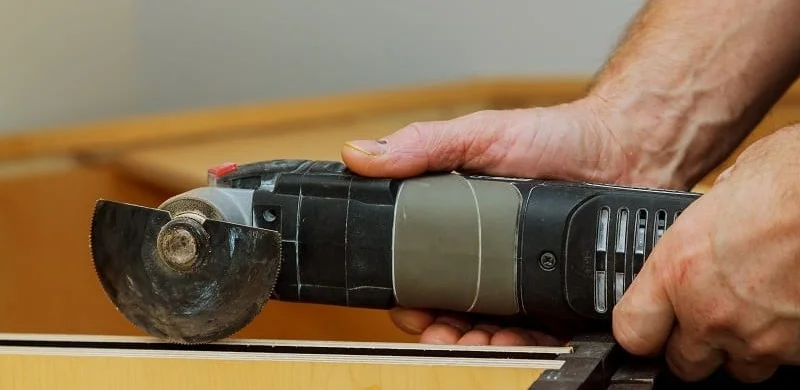Oscillating tools are an essential group of multifunctional power tools that can be useful in DIY or professional work.
From sanding to cutting, grinding, and scraping tasks, oscillating tools can work with a variety of materials and applications.
However, the full potential of this tool can only be realized with proper skills and adequate practice.
With this in mind, below are some tips that can help you improve your oscillating tool usage and perfect your projects.
1. Choose the Right Blade for the Job
Among all the elements of oscillating tool operation, the choice of the working blade is one of the most critical ones. An oscillating tool comes with different attachments that include wood cutting, metal cutting, and grout removal blades.
Ultimately, it is essential to know in advance which blade is most suitable for a specific job so that the results are optimal and the lifetime of the blade maximal. For instance, a wood blade becomes blunt very fast when used on metal surfaces, while a metal blade may cause damage on wooden surfaces.
Tip: It is advised to buy a multi-purpose blade set with every blade labeled to avoid confusion.
2. Set the Correct Speed
Many oscillating tools come with speed controls, which you can set depending on the type of surface that you are cutting. A slow speed is always better to use when cutting softer materials.
This is because of the less friction a slow speed produces, which, in turn, makes it less likely to scorch or melt the material. Using higher speed is appropriate for more rigid materials such as metals or tiles.
Tip: Learn the different speed options on your tool and begin with the lowest that is obtainable. When working on the material and becoming more familiar with it, it is recommended to slowly move up the notch in terms of speed.
3. Practice Proper Hand Placement
The way you grip your oscillating tool will help you manage the vibrations and make the right and most effective cuts or work on the task at hand. A firm grip that is not too tight will ensure better control and accuracy of the shot.
Also, having both hands as stable as possible is crucial, especially when working on delicate operations. If more force is needed in your project, make sure to lock your arms and ensure your body has the correct posture.
Tip: Practice your posture and hand placement on some waste material when working on a project. By doing so, you’ll be able to enhance your general tool-handling skills and build muscle memory.
4. Use the Right Amount of Pressure
There is always the temptation to get closer and apply more pressure to such a tool when working on some projects. This is a big no.
Using harder pressure may also reduce the overall life expectancy of the blade and increase the risk of harm to the material in use. Instead, let the tool work as intended. This back-and-forth movement is supposed to get rid of the material without too much force.
Tip: Exert just enough force to maintain contact between the tool and the material you are using. There are times when the tool is not cutting efficiently. Ensure you use the correct blade and speed before applying pressure.
5. Make Use of the Depth Stop
Some oscillating tools feature a depth control that enables the user to set the depth limit to which the tool can cut in. This feature is particularly useful when dealing with delicate operations such as plunge cutting or shaving small sections of the material.
It also makes it possible to avoid cutting the material to the wrong depth, affording a cleaner and more accurate finish.
Tip: When working on delicate or thin materials, constantly adjust the depth stop before beginning your task. In addition to preserving control, this avoids unintentional damage.
6. Experiment with Different Angles
Oscillating tools are incredibly potent because they can be utilized at various angles. For instance, cutting at an angle of 90 degrees will produce a different outcome than cutting at an angle of 45 degrees.
Knowledge of such angles can help utilize new fascinating opportunities to fulfill the work in complicated angles and limited access.
Tip: Experiment with the oscillating tool at various angles and on multiple types of materials to find which angles are more useful in different applications. This helps to improve your understanding and practical skills in applying the tool to the needs of any project.
7. Work in Short Bursts
Extending cuts in a single, lengthy motion is a standard error made by beginners while utilizing oscillating equipment. Continuous and extended cuts can lead to the tool overheating and provide unreliable results.
Use quick, deliberate passes instead when working with thick or strong materials.
Tip: A helpful tip is to take regular rests between cuts to cool down the blade and the instrument. This prolongs the life of your tool by lowering the possibility of overheating the engine or burning out your blades.
Conclusion
Choosing the appropriate blade, utilizing the proper methods, and routinely maintaining the tool are all essential to becoming an expert oscillating tool user.
Whether you’re doing complex DIY projects, house repairs, or maintenance, these strategies will help you manage a wider range of jobs more effectively.
Your oscillating tool will become an essential item in your toolbox as you get more familiar with it and realize how well it works with any material and under any circumstance.









